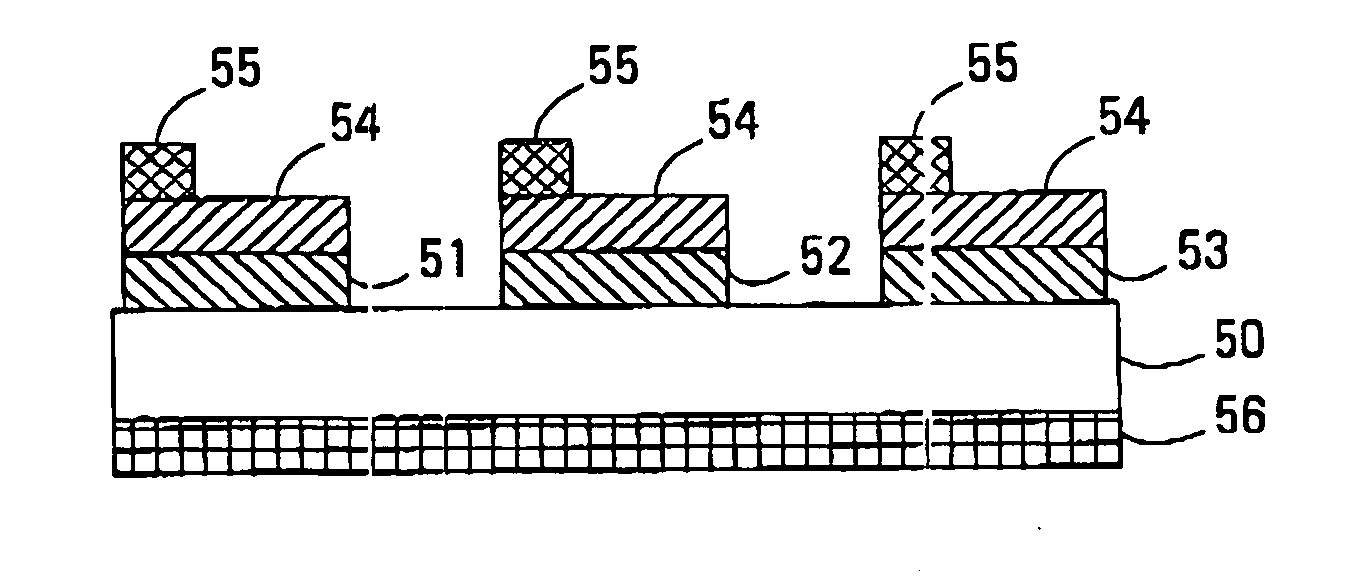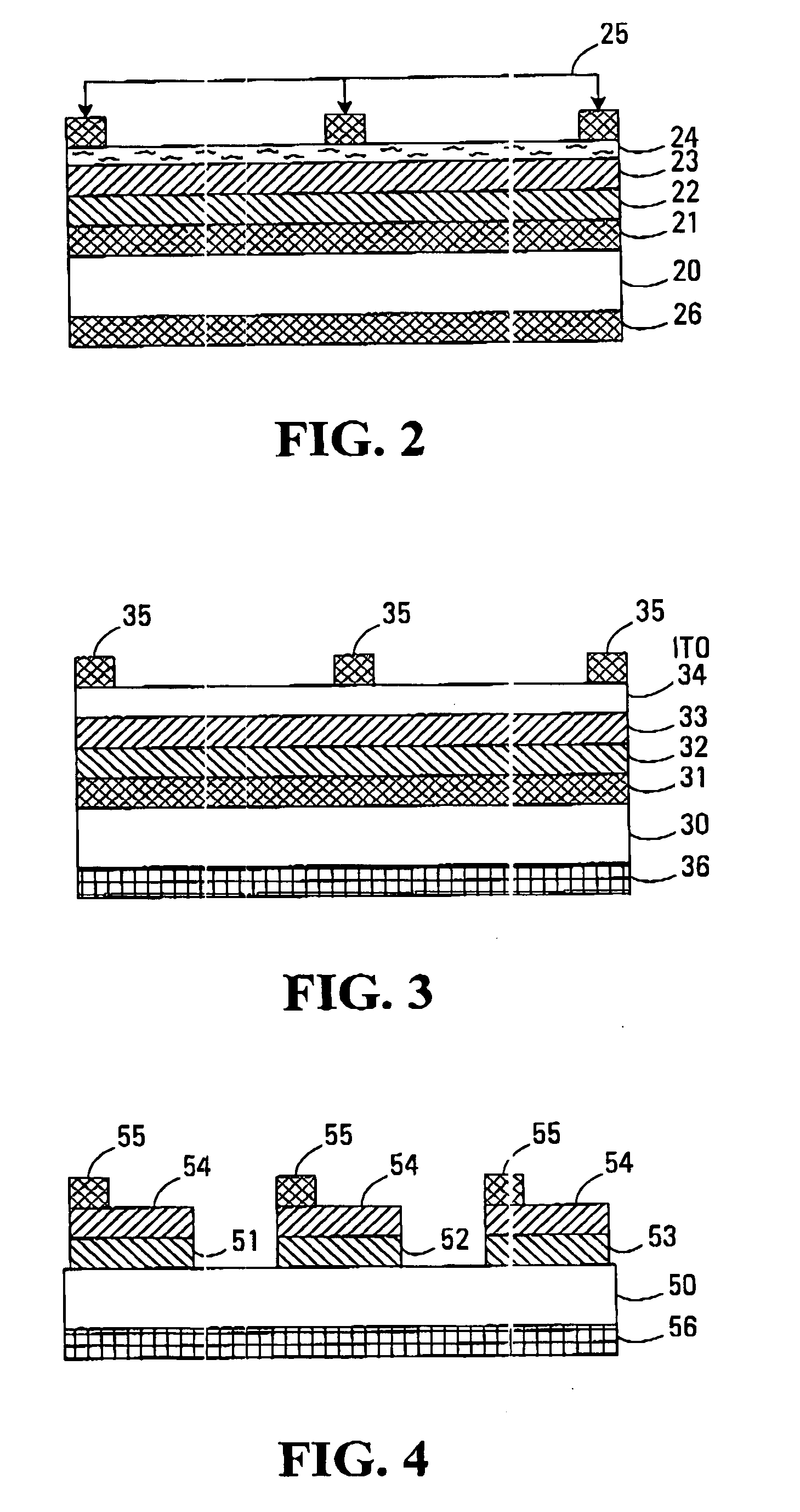Solid state white light emitter and display using same
a light emitter and white light technology, applied in the direction of semiconductor devices for light sources, sustainable buildings, light and heating equipment, etc., can solve the problems of unreadable display, unsuitable replacement, and limited light output of leds,
- Summary
- Abstract
- Description
- Claims
- Application Information
AI Technical Summary
Benefits of technology
Problems solved by technology
Method used
Image
Examples
example 1
[0189] Silane (SiH4) and Oxygen (O2) are added to an argon plasma stream produced by an Electron Cyclotron Resonated (ECR) reactor via dispersion ring. The ratio (Q) of silane to oxygen has been varied between 3:1,1.7:1,1.2:1,1:1.9, and 1:2. An erbium precursor (Tris(2,2,6,6-tetramethyl-3,5-heptanedionato) erbium(III) [Er+3(TBMD)3]) is placed in a stainless steel oven held between 90 and 110° C.
[0190] A carrier gas of Ar is used too transport the Er precursor from the oven through a precision controlled mass-flow controller to a dispersion ring bellow the Silane injector and above the heated substrate. The instrument pressure is kept at about 1×10−7 torr. The substrates used are either fuse silica or silicon wafers on which is thermally grown an oxide layer of 2000 nm thickness. The deposition temperature, the microwave power and the sceptre bias are kept constant at 300° C., 400W and −200Vdc. The SiH4, Ar flow rates were adjusted while keeping the O2 flow rate at 20 militori sec−1...
example 2
[0191] An ablation target is fabricated by combining powdered silicon, powdered silicon dioxide and powdered erbium oxide, the prepared powder mixture comprising 45% silicon, 35% silicon oxide and 20% erbium oxide. Each powder component has a size of about 300 mesh. The mixture is placed into a ball mill and ground for approximately 5 to 10 minutes. The mixture is then placed into a 25 mm diameter by 7 mm thick mould, placed into a hydraulic press, and compressed for 15 minutes at 500 psi. The obtained target is then placed into an annealing furnace and heated to 1200° C. in a forming gas atmosphere of 5% H2 and 95% N2 for 30 minutes. The Target is cooled down to room temperature and then reground in a ball mill for ten minutes. The mixture is then again placed in a mould, compressed and annealed as described above. The obtained target is placed onto a target holder inside a vacuum chamber. A silicon substrate [n-type, single crystal, 0.1-0.5 Ωcm conductivity] of 50 mm diameter and...
example 3
[0193] A gas pyrolysis apparatus was; fitted with a small tubular furnace having a length of 3 cm and an interior diameter of 12 mm. While the furnace temperature was held between 900 and 950° C., an argon carrier gas, silane (SiH4), and Er+3(THMD)3 were introduced to the furnace by way of precision mass-flow controllers. The Er+3 (THM)3 was transferred to the gaseous phase through the use of a temperature controlled oven. The flow through the apparatus was assisted by a mechanical vacuum pump at the end of the apparatus. Once through the furnace, the gaseous stream was allowed to pass through a cooling zone and then to pass through a two-stage bubbler of ethylene glycol. The ethylene glycol solution was removed from the bubbler and it was vacuum dried to cover Er doped Si nanocrystals having an average diameter of about 3 nm.
PUM
| Property | Measurement | Unit |
|---|---|---|
| thickness | aaaaa | aaaaa |
| grain size | aaaaa | aaaaa |
| grain size | aaaaa | aaaaa |
Abstract
Description
Claims
Application Information
 Login to View More
Login to View More - R&D
- Intellectual Property
- Life Sciences
- Materials
- Tech Scout
- Unparalleled Data Quality
- Higher Quality Content
- 60% Fewer Hallucinations
Browse by: Latest US Patents, China's latest patents, Technical Efficacy Thesaurus, Application Domain, Technology Topic, Popular Technical Reports.
© 2025 PatSnap. All rights reserved.Legal|Privacy policy|Modern Slavery Act Transparency Statement|Sitemap|About US| Contact US: help@patsnap.com



